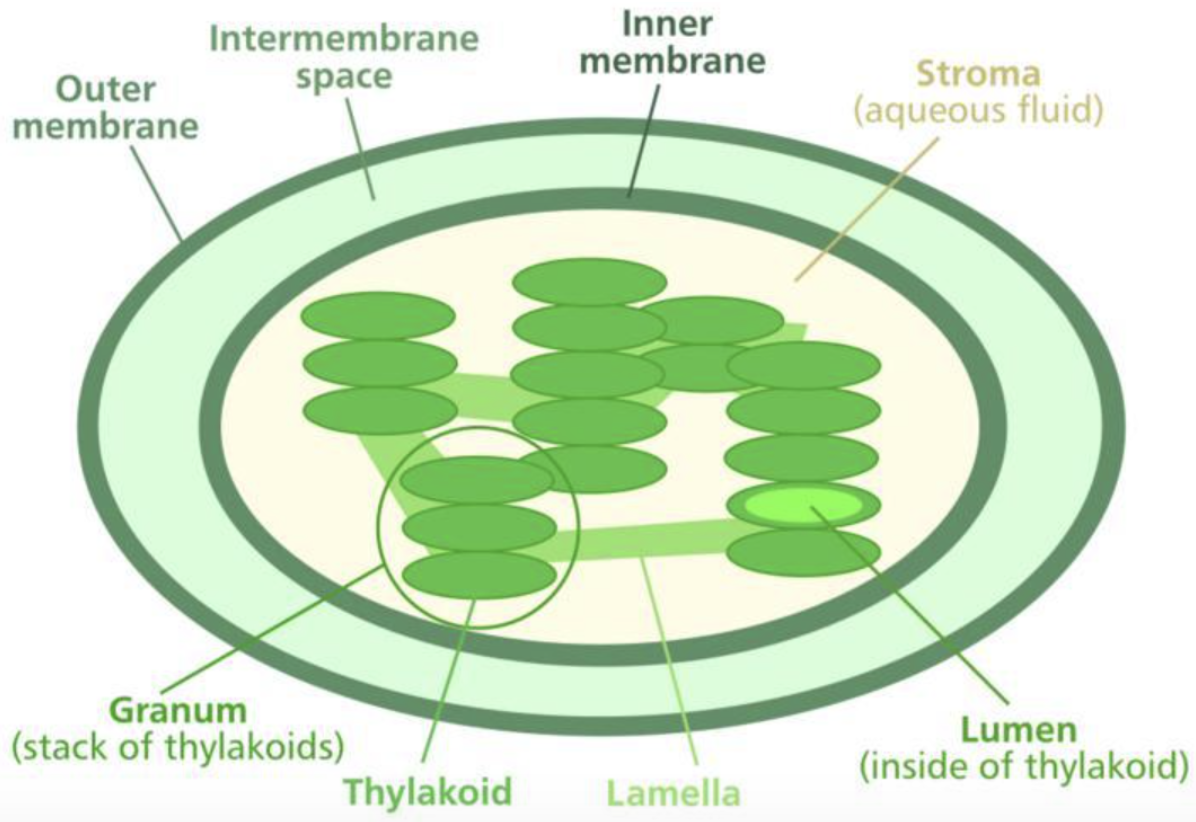
In chloroplasts, the chlorophyll is present in the
(a) Stroma
(b) Outer membrane
(c) Inner membrane
(d) Thylakoids
Answer
561k+ views
Hint: Chloroplasts carry out a number of functions in the plant including fatty acid and amino acid synthesis. Chlorophyll molecules are highly reactive and need to be present in specific organelles to carry out their designated function.
Complete answer:
- Chlorophyll is a pigment necessary for photosynthesis where it helps plants to absorb energy from light. It is located in the thylakoid membranes of the chloroplasts.
- Thylakoids are membrane-bound compartments present inside chloroplasts. The compartment consists of the thylakoid membrane, where chlorophyll exists, and thylakoid lumen. The thylakoid membrane is where the light-dependent reactions of photosynthesis occur.
- Individual thylakoid discs are stacked on top of each other known as a granum (plural: grana) . These stacks are present in the stroma i.e. the matrix of the chloroplast.

So, the correct answer is ‘Thylakoids’.
Additional Information:
- The grana are connected to each other by lamellae or stroma thylakoids.
- Stroma is the colorless matrix that surrounds the grana in the chloroplast. It is the site for Calvin cycle reactions and chloroplast DNA replication.
- The inner and outer membrane form the parts of the chloroplast envelope. They both are lipid bilayers and while the outer membrane is permeable, the inner membrane is highly selective and contains transport proteins.
Note:
- In some ${ C }_{ 4 }$ plants and some algae, the chloroplasts contain free-floating thylakoids.
- The thylakoid membrane is also a site for ATP synthesis.
- Photosynthetic pigments present in the thylakoid are chlorophyll a, chlorophyll b, carotenoids (carotene and xanthophylls) , and plastoquinone.
- Chloroplasts contain 10-100 grana.
Complete answer:
- Chlorophyll is a pigment necessary for photosynthesis where it helps plants to absorb energy from light. It is located in the thylakoid membranes of the chloroplasts.
- Thylakoids are membrane-bound compartments present inside chloroplasts. The compartment consists of the thylakoid membrane, where chlorophyll exists, and thylakoid lumen. The thylakoid membrane is where the light-dependent reactions of photosynthesis occur.
- Individual thylakoid discs are stacked on top of each other known as a granum (plural: grana) . These stacks are present in the stroma i.e. the matrix of the chloroplast.

So, the correct answer is ‘Thylakoids’.
Additional Information:
- The grana are connected to each other by lamellae or stroma thylakoids.
- Stroma is the colorless matrix that surrounds the grana in the chloroplast. It is the site for Calvin cycle reactions and chloroplast DNA replication.
- The inner and outer membrane form the parts of the chloroplast envelope. They both are lipid bilayers and while the outer membrane is permeable, the inner membrane is highly selective and contains transport proteins.
Note:
- In some ${ C }_{ 4 }$ plants and some algae, the chloroplasts contain free-floating thylakoids.
- The thylakoid membrane is also a site for ATP synthesis.
- Photosynthetic pigments present in the thylakoid are chlorophyll a, chlorophyll b, carotenoids (carotene and xanthophylls) , and plastoquinone.
- Chloroplasts contain 10-100 grana.
Recently Updated Pages
The number of solutions in x in 02pi for which sqrt class 12 maths CBSE

Write any two methods of preparation of phenol Give class 12 chemistry CBSE

Differentiate between action potential and resting class 12 biology CBSE

Two plane mirrors arranged at right angles to each class 12 physics CBSE

Which of the following molecules is are chiral A I class 12 chemistry CBSE

Name different types of neurons and give one function class 12 biology CBSE

Trending doubts
One Metric ton is equal to kg A 10000 B 1000 C 100 class 11 physics CBSE

Explain zero factorial class 11 maths CBSE

What is 1s 2s 2p 3s 3p class 11 chemistry CBSE

Discuss the various forms of bacteria class 11 biology CBSE

State the laws of reflection of light

An example of chemosynthetic bacteria is A E coli B class 11 biology CBSE




